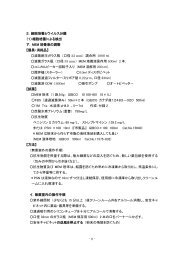Program and Abstracts(PDF)
Program and Abstracts(PDF)
Program and Abstracts(PDF)
You also want an ePaper? Increase the reach of your titles
YUMPU automatically turns print PDFs into web optimized ePapers that Google loves.
Presentation 21<br />
LANDBASED POLY-ECO-AQUACULTURE OF ABALONE AND SEAWEED IN THE<br />
SMALL SCALE RECIRCULATING SYSTEM USING THE RECYCLED FROZEN<br />
CONTAINER<br />
Mohammad Mustafizur Rahman, Kadowaki Shusaku*, Saw Mya Linn <strong>and</strong> Yamada Yohei<br />
Faculty of Fisheries, Kagoshima University, Shimoarata 4-50-20, Kagoshima 890–0056, Japan<br />
*Email: kadowaki at fish.kagoshima-u.ac.jp<br />
To minimize environmental impacts, we wanted to develop a poly-eco-aquaculture of abalone<br />
<strong>and</strong> seaweed in the small scale recirculating aquaculture system housed in the recycled frozen<br />
container. The main objective was to develop a low cost, environment friendly <strong>and</strong> l<strong>and</strong>-based<br />
integrated aquaculture with hybrid abalone (Haliotis discus hannai × H. sieboldii) <strong>and</strong> seaweed<br />
(Ulva sp.).<br />
We conducted two experiments in two small-scale recirculating systems housed in a<br />
recycled frozen container (4.3×1.9×1.9 m). Each system consisted of two biofilters (100 <strong>and</strong> 200<br />
L) <strong>and</strong> two abalone culture tanks (each 200 L). Each abalone culture tank contained three plastic<br />
baskets (each 50 × 34 × 6 cm, with 12 mm mesh). One of these systems also incorporated a<br />
protein skimmer (PS: 100 L).<br />
An air-conditioner (2.8 kw/h) was used to maintain the desired water temperature (19.2 ±<br />
0.8℃). Water circulation was maintained at 43 L per minute. Artificial salt water was used<br />
instead of natural seawater. Salinity of water was 32 ppt. The stocking density of abalone was 20<br />
individuals per basket. Pelleted artificial feed was supplied six days per week at 2.3% of abalone<br />
body weight per day. Temperature, salinity, dissolved oxygen, total ammonia nitrogen, NO 2 –N,<br />
NO 3 –N, PO 4 -P <strong>and</strong> bacterial abundance were regularly monitored.<br />
In the first experiment, 3.5 ± 0.8 cm (shell length) abalone were cultured to investigate the<br />
effects of protein skimming on water quality, abundance of bacteria <strong>and</strong> FCR <strong>and</strong> growth of<br />
abalone. Over an experimental period of 87 days, protein skimming resulted in significantly<br />
better water quality (lower total ammonia nitrogen, NO 2 –N, NO 3 –N <strong>and</strong> bacterial abundance) <strong>and</strong><br />
abalone growth.<br />
In the second experiment, a seaweed culture tank (100 L) of round <strong>and</strong> transparent with<br />
conical bottom was connected with the system with PS to observe the combined effects of protein<br />
skimming <strong>and</strong> seaweed (PSS) on water quality <strong>and</strong> abalone growth. In this experiment, 4.0 ± 0.2<br />
cm (shell length) abalone were cultured for 72 days. Seaweed (Ulva sp.) was stocked (20 g) in the<br />
seaweed culture tank at the beginning of the experiment <strong>and</strong> harvested 63~95 g per week. We<br />
observed significantly higher pH <strong>and</strong> lower TIN <strong>and</strong> TIP concentrations in system with PSS than<br />
the system without PSS. Bacterial abundance was significantly lower in system with PSS<br />
(4.1×10 5 CFU/mL) than the system without PSS (6.4×10 5 CFU/mL). Bacterial abundance in<br />
protein skimmer waste was 2.2×10 7 CFU/mL. Growth rate of abalone in both length (60.0 ± 8.0<br />
µm/day) <strong>and</strong> weight (63.6 ± 15.5 mg/day) was better in system with PSS than the system without<br />
PSS (length 40.0 ± 11.0 µm/day <strong>and</strong> weight 33.8±7.3 mg/day). FCR was observed better in<br />
system with PSS (1.45 ± 0.45) than the system without PSS (2.40 ± 0.26). The survival of<br />
abalone was similar between the system with PSS (96.3 ± 2.5 %) <strong>and</strong> without PSS (97.5 ± 2.5 %).<br />
ANNOTATED BIBLIOGRAPHY OF KEY WORKS<br />
42



